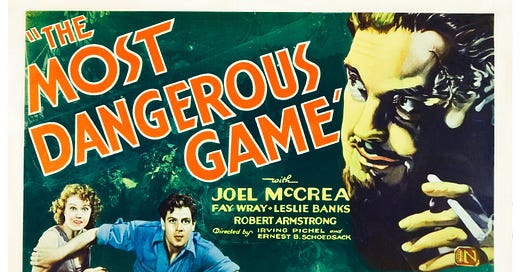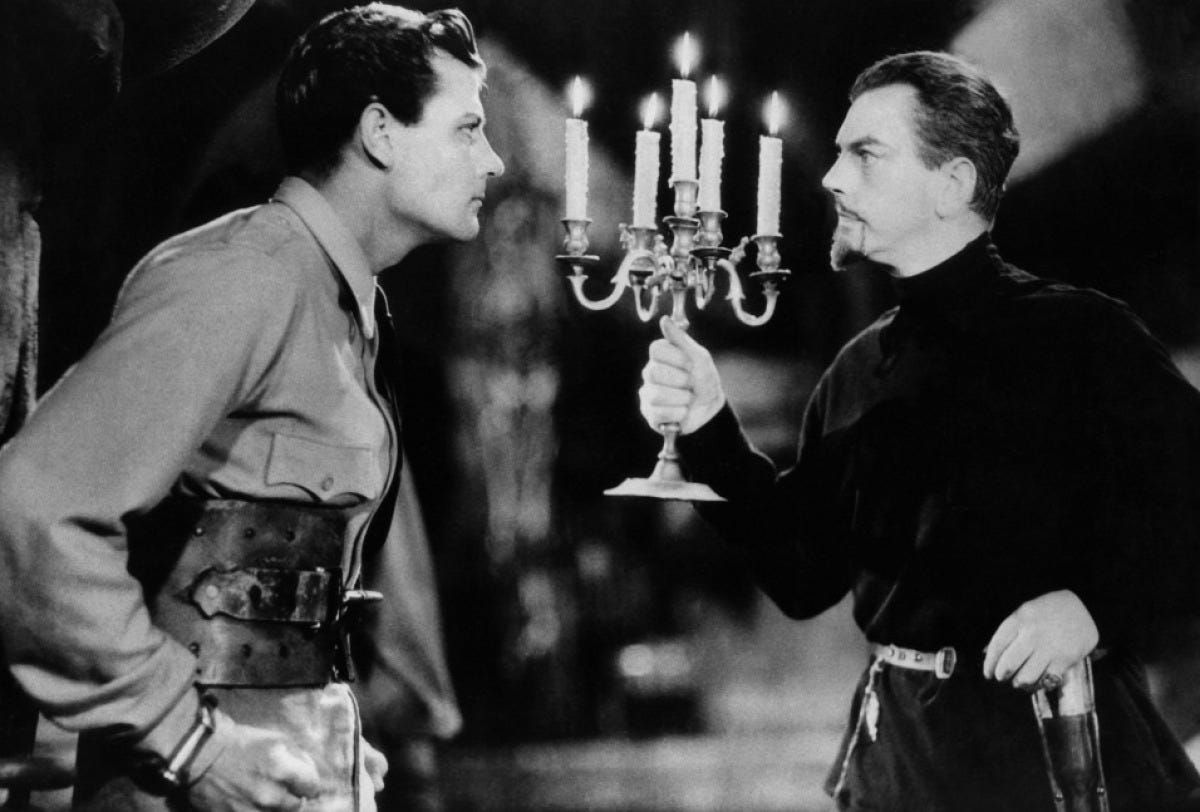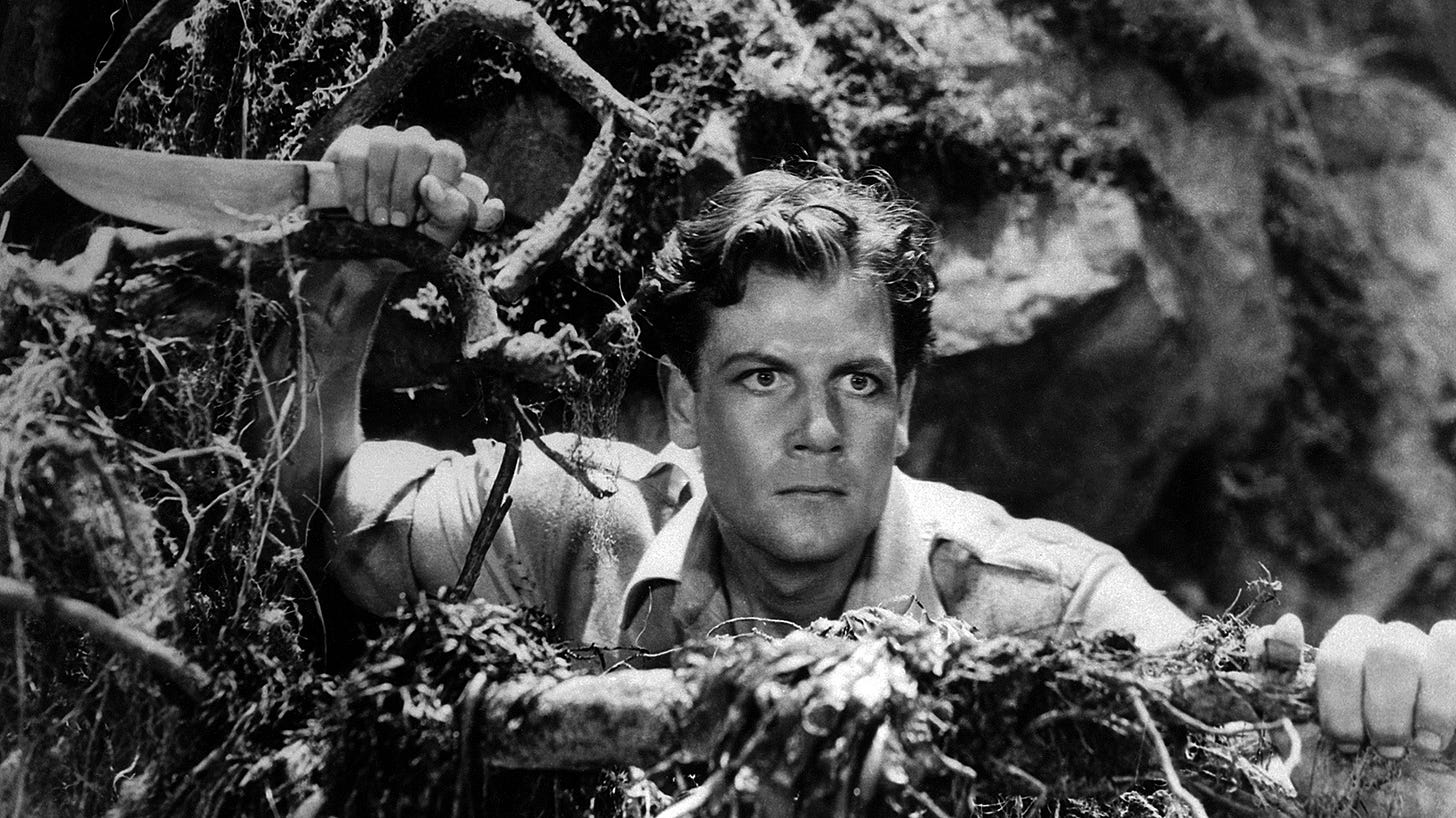The world is made up of two classes — the hunters and the huntees.
- The Most Dangerous Game, Richard Connell
I recently scarfed down a trilogy of 70s “Death Island” movies and it got me thinking about the origin of that concept, the idea of man hunting man. This now common plot device is most notably represented by an old Richard Connell short story called “The Most Dangerous Game.”
It’s been a hundred years since the original story was published and they’re still churning out new versions, but for this review, I thought it would be nice to stick with the originals. First the 1924 short story by Richard Connell, followed by the 1932 film.
To start the short story, Rainsford and his buddy are up late chatting on the deck of a boat cruising in the Caribbean. It’s dark and quiet and they discuss the sinister island they recently passed and the sensation of evil foreboding as they did. They discuss the feelings of a jaguar as it hunted and Rainsford dismisses his pal’s sympathy for the beast. In the literary business, this is called foreshadowing. Rainsford then quickly proceeds to fall overboard and be forced to swim to the sinister island where he will be hunted like a jaguar.
Upon reaching land and resting from his exhaustion, Rainsford discovers a large mansion which he approaches and enters, being greeted by a giant mute with a gun whom we later meet as the Cossack Ivan, the manservant of our antagonist General Zaroff. The General then appears and greets Rainsford warmly. He has even read Rainsford’s book about hunting leopards in Tibet. It is all very cordial and aristocratic. General Zaroff is clearly displayed as a man of high breeding and manners.
At dinner, after a long explanation of how he has grown bored of hunting , General Zaroff admits that he has renewed his passion by hunting humans. Rainsford is aghast and Zaroff simply replies, “I refuse to believe that so modern and civilized a young man as you seem to be harbors romantic ideas about the value of human life.” I thought that a pretty cutting statement, with a good bit of truth behind it judging from the news these days.
Shortly thereafter Rainsford is pushed out into the jungle with a hunting knife and some food and must survive for three days with the vague promise of freedom. On the first day, Zaroff finds him hiding in a tree, but pretends he doesn’t see Rainsford as he enjoyed the chase and longs for more. (This is called hubris.) The next day Rainsford sets up traps and takes out one of the General’s best dogs and his servant Ivan, but Zaroff simply returns to his mansion and has “an exceedingly good dinner,” though expresses annoyance he has to find a new servant. The final confrontation comes shortly thereafter and it ends with the General being fed to his dogs and Rainsford sleeping in Zaroff’s “very excellent” bed. There’s an awesome last line for sure.
It’s a good story and has a quick pace. It has a certain social and moral consciousness, a couple of solid characters, and it’s clear why the basic shape has set up so many subsequent tales. There’s not a lot of wasted effort or backstory or resolution, leaving it open to endless interpretation and extrapolation. Many many many have been attempted. Let’s see how the first film version does.
The Most Dangerous Game (1932) starts with a bit different set up than the story. There are several well-to-do characters on a fancy yacht chatting away, which elevates the underlying class themes as their overconfident bluster overriding the working seamen leads to a shipwreck and all of them dying save Rainsford. The deaths are pretty bloody for such an old movie as sharks rip up a couple dudes and the boat explodes.
Rainsford carries on to the house, where he meets a Count instead of a general, who is played hammy as Porky Pig by Leslie Banks. It’s a good portrayal, but not quite so threatening as one might like. Unlike the story, there are other guests at the manor, a sister and brother pair giving us Robert Armstrong as the drunk comic relief and Fay Wray as the love interest.
Armstrong’s character’s lack of seriousness and general antics clearly annoy the Count so he is introduced to the secret trophy room filled with human heads. Rainsford wakes up to the sound of barking dogs and sister banging on his door saying brother is missing. She leads Rainsford into the trophy room and they find the human heads and her bro dead in a sack.
The rest unfolds in a similar fashion to the story except Rainsford has a female companion during the hunt which changes the vibe a bit. The ending is not quite so bloody and ruthless as the story - more of an extended goofy fight sequence - though possibly the dogs still eat the Count.
Overall I prefer the story, but the movie has some nice comedic elements that were absent from the literary version. An interesting note is that apparently The Most Dangerous Game was made around the same time as the original King Kong using the same sets and many of the same actors.




